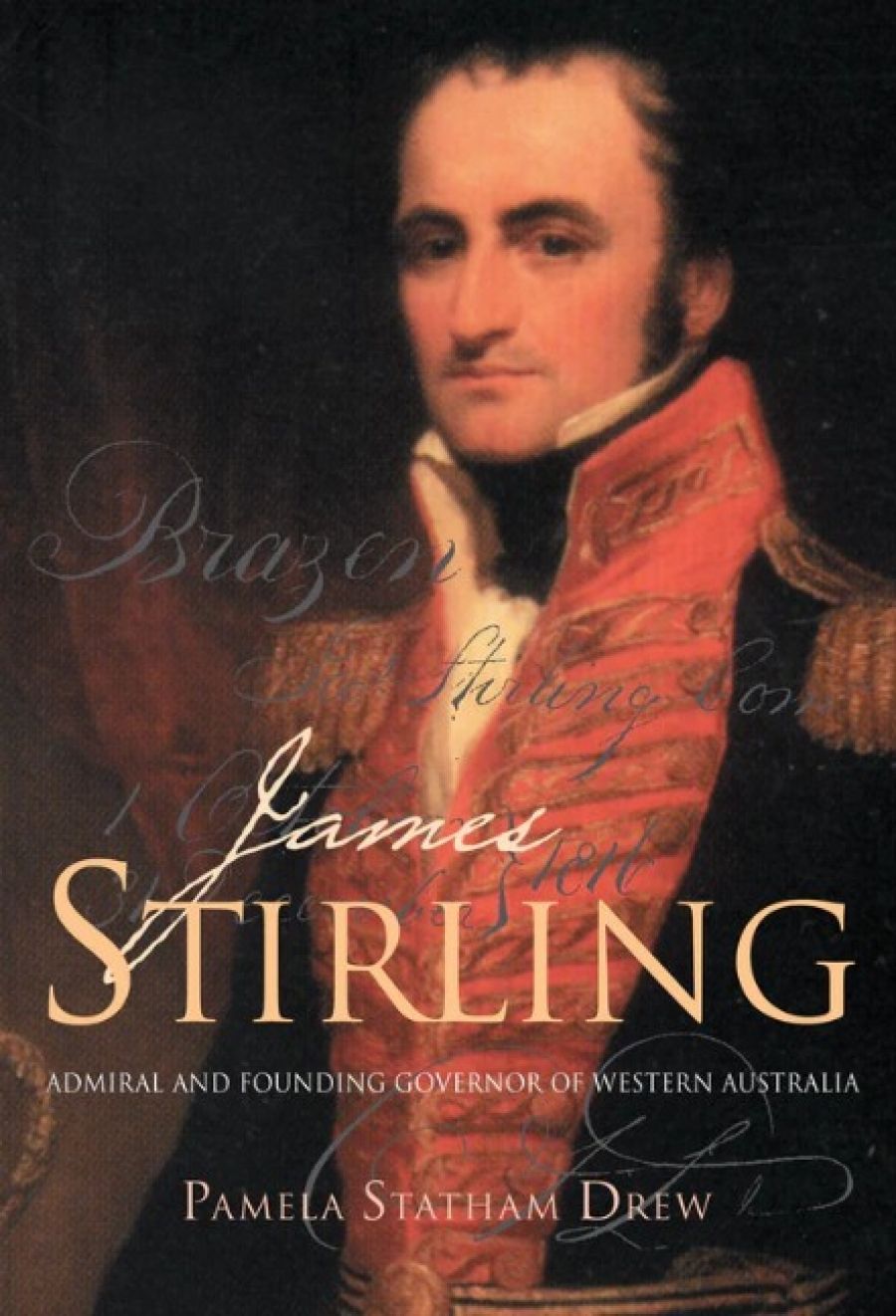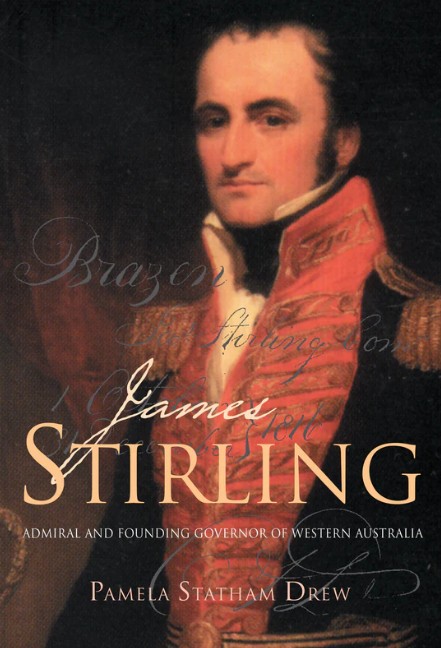
- Free Article: No
- Contents Category: Biography
- Review Article: Yes
- Article Title: Honest Governor
- Online Only: No
- Custom Highlight Text:
James Stirling’s naval career was helped by having an uncle who was a Rear Admiral. The other side of his family was involved in trade, and some have argued that his proposal for the Swan River colony was based on personal ambition and family influence. This is true to some extent. However, in a deeper sense, he was shaped by his family’s involvement in two of the mainsprings of nineteenth-century British imperialism: naval dominance and worldwide trade.
Stirling was the founding governor of Western Australia for ten years, but the major part of his career was with the Royal Navy. A strength of this biography is that it is the first full account of that career. There is too little space in this review to deal fully with this part of his life, and Australian readers will be more concerned with his governorship. Like most colonial Australian governors (and post-colonial ones), Stirling has had his admirers and detractors. The author, obviously an admirer, argues persuasively in his favour.
- Book 1 Title: James Stirling
- Book 1 Subtitle: Admiral and Founding Governor of Western Australia
- Book 1 Biblio: UWA Press, $59.95hb, 670pp
- Book 1 Cover Small (400 x 600):

- Book 1 Cover (800 x 1200):

Stirling, aged thirteen, enlisted in the navy in 1803, and from 1812 to 1818 saw action in the waters off South Africa and South America. He became a respected naval officer and a skilled diplomat; a personable man, humane, adventurous and resilient. But he was something of a loner, and was sometimes considered arrogant. His political views were Whiggish.
He was a competent linguist, having learned Latin and French at Winchester School, where a fellow pupil was Edward Gibbon Wakefield (who later, as a critic of the land grant system used at the Swan River, proposed the Wakefield System used in South Australia). While on the South American Station, Stirling learned Spanish – which led to his being despatched on a secret mission to contact Simon Bolivar. On his return to England in 1818, he was promoted to Post Captain and placed on half pay. He travelled widely, and married Ellen Mangles on her sixteenth birthday. They were a devoted couple; his mother noted that, during long separations on service, he became ‘wifesick’. They had eleven children, seven born in the colony, one child died as an infant. Ellen was a popular and active governor’s wife.
After his governorship, Stirling was posted to the Mediterranean as second in command of the Evolutionary Squadron, charged with developing new tactics for the navy in the age of steam and improved weaponry. He helped to negotiate the settlement of a rebellion against the King of Greece, and was awarded one of that nation’s highest honours. Subsequently, as Commander in Chief, China and East Indies Station, he quelled piracy, was involved in a Chinese rebellion and negotiated the first treaty between Britain and Japan, shortly after Commodore Perry had obtained rights of entry for the US.
He had returned to active service in 1826, in command of HMAS Success, and was despatched to Sydney with a load of specie, charged to ascertain the extent of French interest in claiming the western portion of Australia. He was also to visit the remote settlement of Melville Island, which had run into difficulties. However, at a time of the year when the weather was unpropitious in that area, Stirling proposed to Governor Darling that he explore the west coast for a site of settlement. He spent most of March 1827 exploring sea anchorages and the potential for a settlement at the Swan River. With a party including the botanist Fraser, he explored the Swan as far as the present site of Guildford, and reported favourably on the quality of the soil.
He advocated a colony to prevent the French claiming the western part of Australia, and as a convenient convalescent station for British troops and civilians in India. Back in England in 1828, faced with going on half pay, he campaigned vigorously for the establishment of a colony at Swan River and offered to be governor. He was not entirely responsible for the ensuing ‘Swan River Mania’, which was whipped up by exaggerated press reports.
Eventually, the British government sanctioned the colony, which was to
be established by private enterprise and was expected to be self-supporting. The decision was based on limited exploration and hasty planning. Stirling, who had to wait three years after the founding of his formal commission as governor, was briefed inadequately and provided with too small a civil settlement. However, with determination and some bluff, he governed efficiently while awaiting more detailed briefing. His ability as an administrator came to be respected. He had an able Surveyor-General, J.S. Roe – who remained in the service of the colony for four decades – but, with inadequate staff, the surveys for land grants did not proceed as rapidly as the new settlers wished, and there was less fertile land than expected. Pamela Statham-Drew’s account of Stirling’s governorship is very detailed and will enhance his reputation for competence.
He has been criticised for ‘grubbing land’. However, he and some of the other officials were not paid, or were inadequately paid, and grants of land were their compensation. The author answers this charge persuasively. Stirling did not make a fortune from his estates.
Stirling has also been criticised for the ‘Battle of Pinjarra’, during which members of the Murray tribe were killed; estimates vary from fifteen to thirty. Quotations from Stirling’s despatches and decrees show that he was sympathetic to the natives and wanted them to be treated justly. He sought resources to establish a police force, since, despite being a naval officer, he did not think that the military would handle the natives with sufficient forbearance. On two occasions, he spoke of ‘invaders’ and ‘invaded’. He formed views about reserving land for Aborigines, and instructed that they be treated equally with the settlers, though, when pardoning a native for murdering another, he commented that the action would have been sanctioned by native law.
Two tragic events occurred during Stirling’s two-year absence in London. An elder of the tribe, Midgegooroo, was captured, implicated in the murder of two white boys and, two days later, executed by firing squad, without trial. His son, Yagan (a leading settler, George Fletcher Moore, describes him as ‘the Wallace of his tribe’), was killed by two youths. These tragedies might not have occurred had Stirling been present. On his return from England, he discovered that another native, Weeip, had been declared an outlaw and that a reward had been offered for his capture dead or alive. ‘Stirling wanted the proclamation rescinded, given assurances from the tribe of future peaceable behaviour.’ Some spearings of settlers and petty theft, as well as the killing of stock, inflamed public opinion; too few settlers accepted that they were invaders.
The Murray River tribe was reported to be more aggressive towards settlers and other tribes; this was no doubt due to the invasion of their lands. Stirling led an expedition to Pinjarra on the Murray to deal with the situation. The killing that followed appears to have been a tragic blunder, due partly to a lack of clear rules of engagement and to the dispersal of Stirling’s party into several smaller parties out of touch with each other. For that, Stirling must surely take considerable responsibility.
He retired in 1856 and was appointed admiral in 1862. However, his health had been impaired by the rigours of the Far East appointment, during which he may have contracted malaria, and he died in 1865. In a farewell speech to the colony, he said that he had always endeavoured to be an honest man; on the evidence of this biography, he succeeded.
Statham-Drew has been well served by the publishers. This is a handsome volume, with good maps and generous colour illustrations. The author was well qualified by earlier research to undertake this work, and she has had access to family archives, not previously researched. The result is an excellent biography whose detail only occasionally interrupts the narrative flow. It will be definitive for at least a generation.


Comments powered by CComment